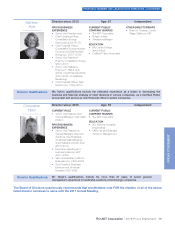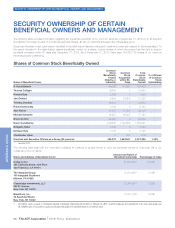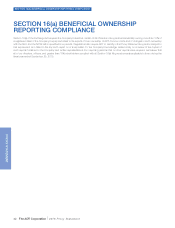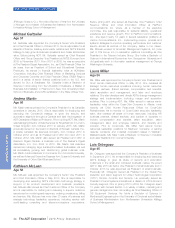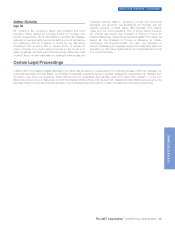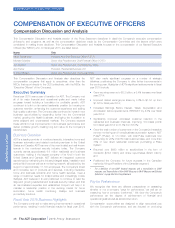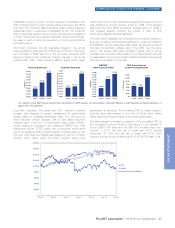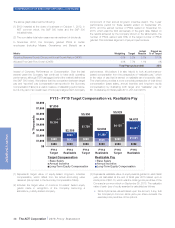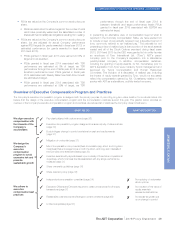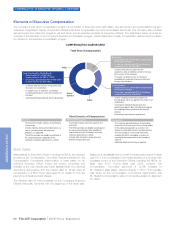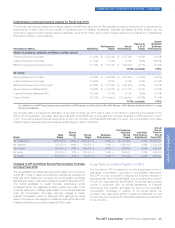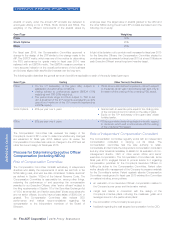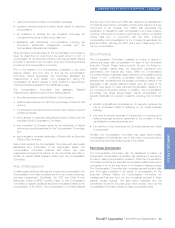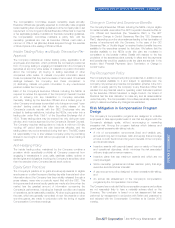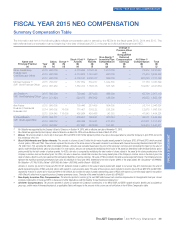ADT 2015 Annual Report Download - page 39
Download and view the complete annual report
Please find page 39 of the 2015 ADT annual report below. You can navigate through the pages in the report by either clicking on the pages listed below, or by using the keyword search tool below to find specific information within the annual report.
COMPENSATION OF EXECUTIVE OFFICERS—CONTINUED
•RSUs are valued at the Company’s common stock price per
share.
•RSUs are accounted for without regard to the number of units
which have previously vested and the associated number of
shares withheld to satisfy tax obligations resulting from vesting
•PSUs are valued at the Company’s common stock price per
share, but are adjusted for actual Company performance
against PSU targets (for grants awarded in fiscal year 2013) or
estimated performance (for grants awarded in fiscal years
2014 and 2015).
•PSUs granted in fiscal year 2013 were earned at 35% of
target amount awarded.
•PSUs granted in fiscal year 2014 associated with TSR
performance are estimated at 0% of target, as TSR
performance through the end of fiscal year 2015 is below
threshold performance level; PSUs granted in fiscal year
2014 associated with Steady State Free Cash Flow Growth
are estimated at target.
•PSUs granted in fiscal year 2015 associated with TSR
performance are estimated at 89% of target, as TSR
performance through the end of fiscal year 2015 is
between threshold and target performance levels; PSUs
granted in fiscal year 2015 associated with EBITDA are
estimated at target.
In presenting an alternative view of compensation beyond what is
reported in the Summary Compensation Table, we have elected not
to include a view of pay actually received over a specified period of
time, commonly referred to as “realized pay.” The rationale for not
presenting a view of realized pay is that a portion of the stock awards
vested and all of the Stock Options exercised during fiscal years
2013, 2014 and 2015 by the CEO were granted to him while he was
an employee of Tyco International Ltd. (“Tyco”), ADT’s parent
company prior to the Company’s separation into a standalone
publicly-traded company. In addition, compensation decisions,
including the granting of equity awards, for Mr. Gursahaney prior to
ADT’s separation from Tyco were made by Tyco’s management and
approved by Tyco’s Compensation and Human Resources
Committee. The inclusion of a discussion of realized pay, including
the impact of equity awards granted by Tyco, would not accurately
reflect the compensation earned by Mr. Gursahaney relative to his
service with ADT as a standalone, publicly-traded company.
Overview of Executive Compensation Program and Practices
The Company’s executive compensation program is designed with the primary purpose of promoting long-term value creation for our stockholders. We
believe that the design of the executive compensation program and the compensation practices support this goal. The graphic below provides an
overview of the Company’s executive compensation program and practices, as well as a list of practices the Company does not adhere to.
WHAT WE DO WHAT WE DON’T DO
We align executive
compensation with
the interests of the
Company’s
stockholders
✓Pay clearly aligned with performance (page 26)
✓Executive compensation program designed to ensure majority of value is at risk
(page 30)
✓Double-trigger change in control provisions for cash and equity awards
(page 37)
We design the
Company’s
executive
compensation
program to avoid
excessive risk and
promote
sustainable growth
✓Mitigation of undue risk (page 37)
✓Mix of compensation components (fixed and variable pay, short- and long-term
incentives) that encourage focus on both the short- and long-term interests of
the Company and its stockholders (page 30)
✓Incentive awards with payouts based upon a variety of financial and operational
objectives, which minimizes the risk associated with any single performance
measure (page 31)
✓Share ownership guidelines (page 36)
✓Share retention policy (page 36)
We adhere to
executive
compensation best
practices
✓Independent compensation consultant (page 34) ✗No repricing of underwater
stock options
✓Executive Officers and Directors required to obtain pre-approval for all equity
transactions (page 37) ✗No inclusion of the value of
equity awards in
severance calculations
✓Reasonable post-employment/change in control provisions (page 46) ✗No excise tax gross-ups
upon change in control
✓Limited perquisites (page 36)
The ADT Corporation 2016 Proxy Statement 29
PROXY STATEMENT


